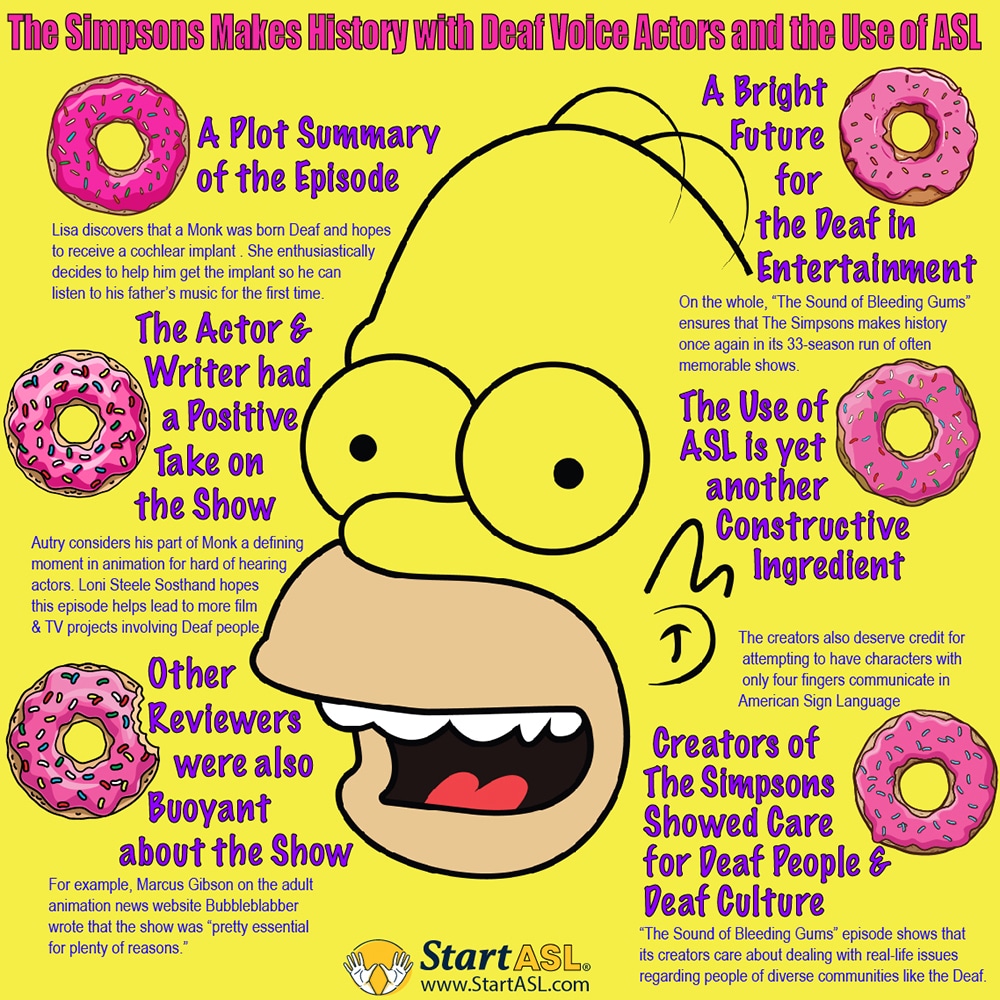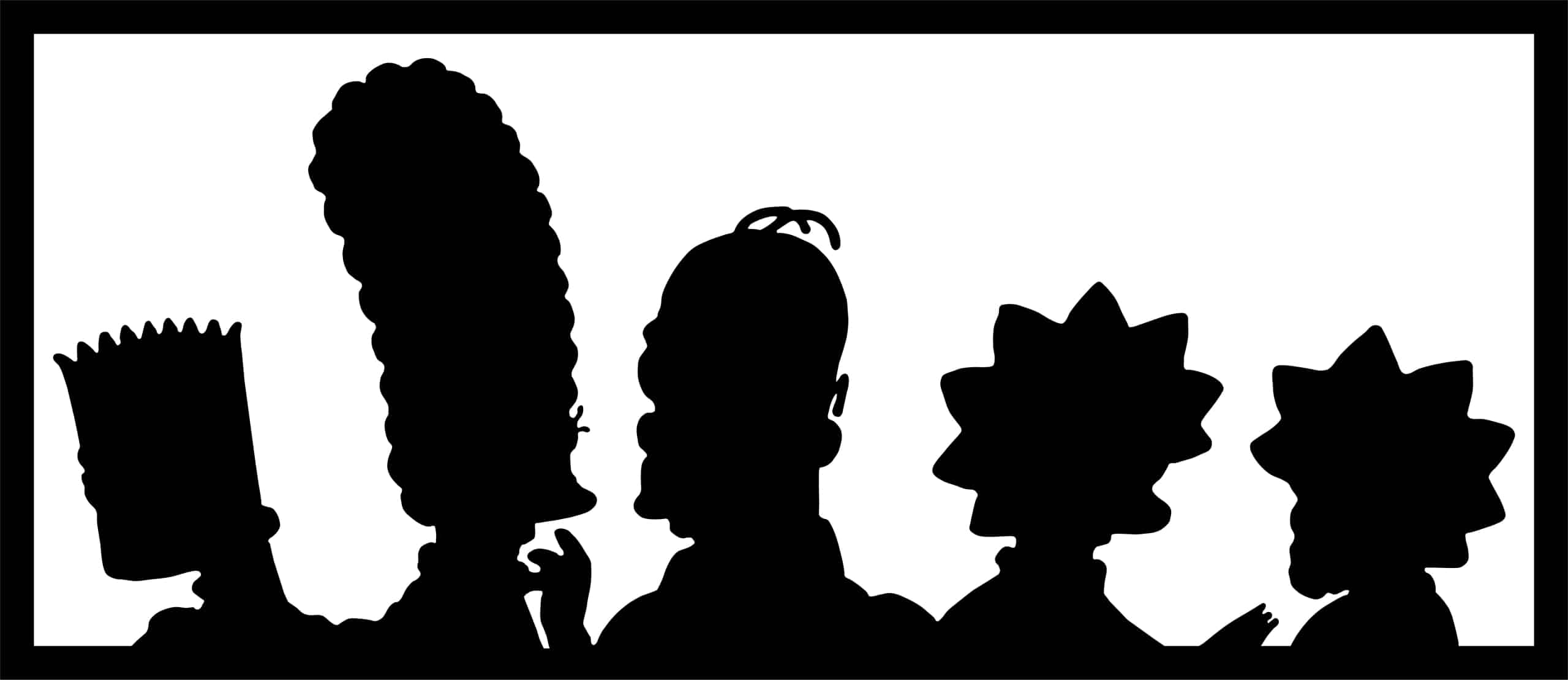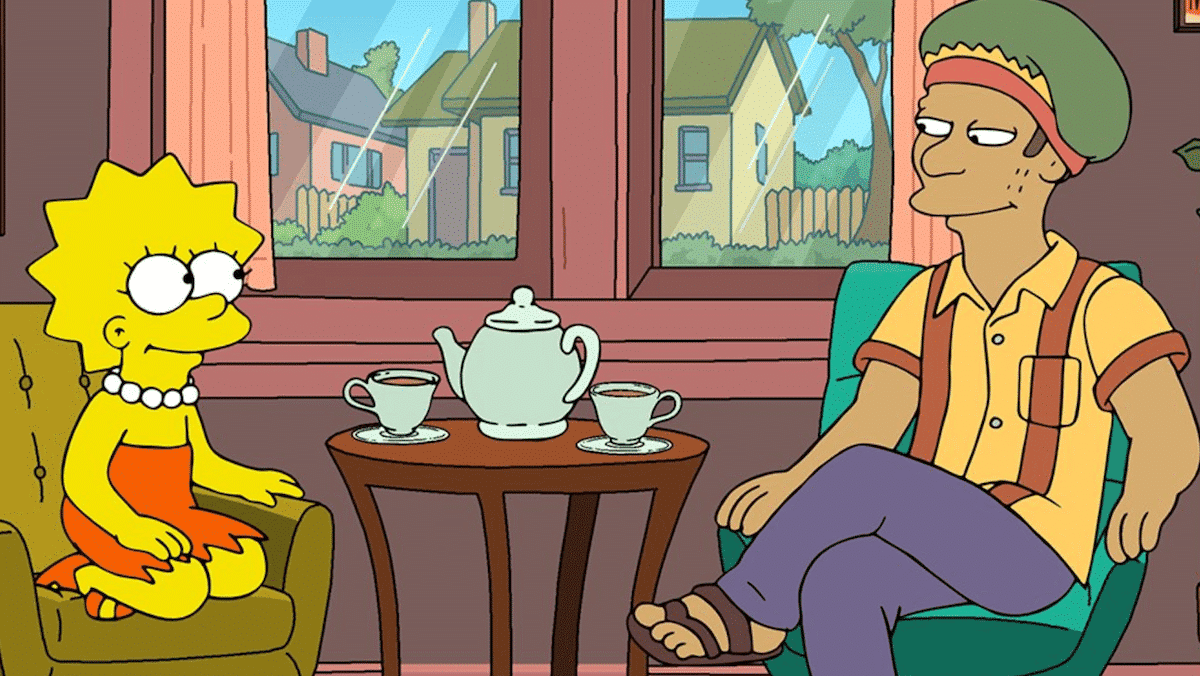
The Simpsons Makes History with Deaf Voice Actors and the Use of ASL

Season 33, episode 17 of the long-running hit animated sitcom The Simpsons titled “The Sound of Bleeding Gums” is noteworthy for its use of American Sign Language (ASL) (although the characters have only four fingers), and for its casting of Deaf actor John Autry II to voice the Deaf character Monk. Through this role, Autry became the first Deaf performer to voice a character on the show.
The episode also features a number of other Deaf performers, such as comedian Kathy Buckley and three youngsters, Kaylee Arellano, Ian Mayorga, and Hazel Lopez from No Limits, a nonprofit organization devoted to deaf children. This fact reinforces the impact of “The Sound of Bleeding Gums” as a turning point in US entertainment history for the Deaf community.
The Simpsons

The Simpsons is an animated American sitcom that satirically portrays life in the United States, as exemplified by a dysfunctional working-class family, which includes husband and wife Homer and Marge, and their children Bart, Lisa, and Maggie. The program is set in the imaginary town of Springfield and lampoons US culture and society, as well as human existence in general. The Simpsons is the longest-running US animated TV series, the longest-running US sitcom, and the longest-running US scripted primetime TV series, with regard to both seasons and number of episodes.
The great popularity, enduring nature, and cultural influence of The Simpsons along with the fact that it featured Deaf voice actors and the use of ASL in an episode makes “The Sound of Bleeding Gums” that much more significant for Deaf and hard of hearing people.
A Plot Summary of the Episode
In “The Sound of Bleeding Gums” Lisa meets Monk, the son of the late jazz saxophonist Bleeding Gums Murphy, her musical idol who passed away in season six of the series. She discovers that Monk was born Deaf and hopes to receive a cochlear implant someday. She then enthusiastically decides to help him get the implant so he can listen to his father’s music for the first time.
It ends up that Monk was able to afford his cochlear implant by winning the Springfield lottery. The episode concludes with Monk having received his cochlear implant and listening to his late father Bleeding Gums ‘ saxophone playing on his father’s memorial bridge. When notes from the recording travel into Monk’s implant, a single tear emerges from his eyes, showing the emotional impact of the new experience of hearing.

The Actor and Writer had a Positive Take on the Show
In describing his role in the episode to a reporter for Variety magazine, John Autry said, “It’s so incredible. “It’s life-changing equality and participation. This can impact change for all of us. It’s about hard of hearing and hearing characters coming together. It’s a part of history.” Autry considers his hiring for the part of Monk a defining moment in animation for hard of hearing actors and the characters they can portray when given the green light by creative decision-makers in entertainment.
This kind of reaction to the show is common among many online reviewers and others as well, who see the show as a groundbreaking step toward greater inclusivity and equality in society for the Deaf and Hard of Hearing. For example, Loni Steele Sosthand, who wrote the episode, has a brother who was born Deaf and hopes that the 2021 Oscar-winning film CODA, which features a largely deaf cast, and her episode of The Simpsons will help lead to many more film and TV projects that involve Deaf people and Deaf culture.
Other Reviewers were also Buoyant about the Show
Many others who wrote reviews regarded “The Sound of Bleeding Gums” with similar enthusiasm. For example, Marcus Gibson on the adult animation news website Bubbleblabber wrote that the show was “pretty essential for plenty of reasons.” The main reasons Gibson cites are that (as mentioned above) it’s the first episode in the history of The Simpsons to include a Deaf actor, and the characters briefly use ASL at the end of the show to communicate.
In light of the Deaf community’s 2022 victories at the 94th Academy Awards, with CODA winning Best Picture, the film’s star Troy Kotsur taking home Best Supporting Actor, and writer-director Siân Heder winning Best Adapted Screenplay, Gibson says it was good to see The Simpsons represent the Deaf and hard of hearing population through animation. It took the show thirty years to finally feature the community, and it paid off well.
Creators of The Simpsons Showed Care for Deaf People and Deaf Culture
“The Sound of Bleeding Gums” installment of The Simpsons shows that its creators care about dealing with real-life issues on the show, especially regarding people of diverse communities like the Deaf. For instance, to voice the Deaf character Monk they chose Deaf actor John Autry II, who gave a stellar performance. Another thing is the script that was thoughtfully composed by Loni Steele Sosthand, whose brother was born Deaf.
In addition, details related to Deaf culture were carefully presented. For example, when Lisa rings Monk’s doorbell, a light flashes. Although Deaf people can’t always hear the sound of a doorbell, they can still see the flashing light. They know that someone’s at the door when the bell rings. In this case, the light was red. This realistic detail added credence to the story line of “The Sound of Bleeding Gums”. It was a further sign of the creator’s concern about accurately presenting Deaf people’s experience in a hearing world.
And at another point in the episode Monk says to Lisa, “I’m not anybody’s cause,” reflecting how Deaf people actually feel. They don’t want pity or help in doing things just because they can’t hear. They believe they’re capable of doing anything a hearing person can do. The Deaf are proud of who they are and being Deaf is an essential part of their identity.
These elements in the story line reveal the writers’, directors’ and producers’ commendable efforts to give legitimacy to the action portrayed in the episode with respect to Deaf identity and culture.
The Use of ASL is yet another Constructive Ingredient
The creators also deserve credit for attempting to have characters with only four fingers communicate in American Sign Language. This process must have been challenging to animate, which could account for the fact that signing is only featured at the end of the episode. It’s a fairly brief sequence, but it’s also fun to see the characters perform the virtually impossible task of signing while lacking a fifth finger. To ensure the accuracy of the ASL used in the episode, the producers employed two ASL consultants, despite the limitation of The Simpsons characters having just four fingers on each hand.
A Bright Future for the Deaf in Entertainment
On the whole, “The Sound of Bleeding Gums” ensures that The Simpsons makes history once again in its 33-season run of often memorable shows. Its portrayal of the Deaf population in action and a solid and thoughtful storyline make it a laudable and momentous segment for the revered sitcom. In addition, a bit of humor was also injected to add fun to the episode, mainly by way of Bart bothering Lisa and a flashback involving Lisa and Bleeding Gums Murphy performing “Driving Miss Daisy” together.
With CODA winning Best Picture and other awards at the 2022 Oscars, and the airing of “The Sound of Bleeding Gums” on The Simpsons, the Deaf community undoubtedly has a bright future ahead in the entertainment industry, especially in the field of animation. The Deaf actor John Autry II provides a great source of inspiration for other aspiring Deaf and hard of hearing actors. His ability to land a starring role star on The Simpsons despite his being Deaf is uplifting and encouraging to both the Deaf and hearing populations alike.










